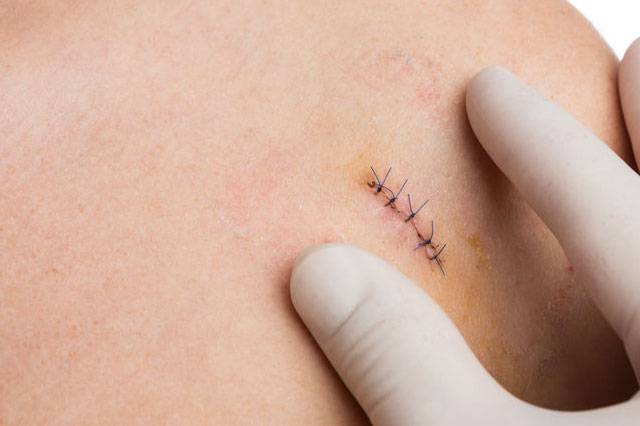Surgical Dermatology at Dallas Dermatology and Aesthetics
Our expert dermatologist diagnose and treat the full range of skin cancers, melanoma, rarer skin malignancies, and other skin lesions. Our surgical suites are equipped with the latest, evidence-based technology. Your comfort is our priority; all our procedures are done under local anesthesia to ensure an optimal experience, and our physicians and staff take time to go through each step of the procedure with you.
Our dermatologist is meticulous dermatologic surgeons and emphasize excellence from beginning to end; he care greatly about both the complete removal of any cancer as well as the cosmetic outcome.
Melanoma
Melanoma is the deadliest type of skin cancer. It is characterized by the uncontrolled growth of pigment-producing cells. If melanoma is caught early, surgical excision at Dallas Dermatology and Aesthetics under local anesthesia may be the only treatment needed.
Melanomas may appear on the skin suddenly without warning but also can develop on an existing mole. Most people have moles. Atypical moles are unusual moles that are generally larger than normal moles and variable in color. They often have irregular borders and may occur in far greater numbers than regular moles. Atypical moles occur most often on the upper back, torso, lower legs, head and neck. The presence of atypical moles is an important risk factor for melanoma developing in a mole or on apparently normal skin. Our dermatologist recommend at least yearly skin cancer screenings for those at risk, in line with the American Academy of Dermatology specialty guidelines.
- New, rapidly growing moles, or moles that itch, bleed, or change color are often early warning signs of melanoma and should be examined.
- If detected early and treated properly, melanoma is highly treatable.
To help you spot skin cancer early, when it’s most treatable, our dermatologist recommend becoming familiar with the ABCDE’s of melanoma:
- A is for Asymmetry: One half of the mole does not match the other half.
- B is for Border irregularity: The edges are ragged, notched, or blurred.
- C is for Color that varies from one area to another.
- D is for Diameter: While melanomas are usually greater than 6mm (the size of a pencil eraser) when diagnosed, they can be smaller.
- E is for Evolving: A mole or skin lesion that looks different from the rest or is changing in size, shape, or color.
Basal Cell Cancer
Basal cell carcinoma is the most common type of skin cancer. The location, subtype, and size will determine what will be the best surgical treatment. Most basal cell carcinomas can be treated by our dermatologist under local anesthesia in the office.
Given time to grow, this skin cancer can grow deep, injuring nerves, blood vessels, and anything else in its path. As the cancer cells pile up and form a large tumor, the cancer can reach into the bone beneath. This can change the way you look, and for some people the change may be disfiguring. Our dermatologist recommend routine skin exams to detect skin cancer as early as possible.
Squamous Cell Cancer
Squamous cell carcinoma is the second most common type of skin cancer. The location, subtype, and size will determine what will be the best surgical treatment. Most basal cell carcinomas can be treated by our dermatologist under local anesthesia in the office.
People usually develop this skin cancer because ultraviolet (UV) light has badly damaged their skin. Most UV light comes from the sun and indoor tanning equipment (tanning beds and sunlamps). This cancer is usually not life-threatening, but it can spread beyond the skin to lymph nodes or other organs. Once it spreads, a patient has advanced cancer. We recommend routine skin exams to detect skin cancer as early as possible.
Atypical Moles
Moles are a common type of skin growth that appear as small, brown spots. Most moles are harmless, but they may become atypical with concerning features of skin cancer. If an severely atypical mole is found, surgical excision at Dallas Dermatology and Aesthetics under local anesthesia may be the appropriate treatment.
Our dermatologist recommend at least yearly skin cancer screenings for those at risk, in line with the American Academy of Dermatology specialty guidelines:
- New, rapidly growing moles, or moles that itch, bleed, or change color are often early warning signs of melanoma and should be examined.
- If detected early and treated properly, melanoma is highly treatable.
Lipomas
Lipomas are benign growths of fat that present as soft lumps and bumps occurring most commonly on the trunk and extremities. Lipomas are usually harmless treatment generally isn't necessary, but if the lipoma bothers you, is painful or is growing, you may want to have it safely removed by our dermatologist in the office under local anesthesia.
Cysts
Sometimes referred to as sebaceous cysts, these benign growths frequently occur on the head or trunk. Occasionally, they may become inflamed and painful. Patients can elect to have them removed, although this is not covered by insurance. Cysts can be safely removed by our dermatologist in the office under local anesthesia.
Earlobe repair
Earlobe repair is done for split earlobe or enlarged earring holes. This is a minor surgical procedure performed by our dermatologist in the office under local anesthesia.







